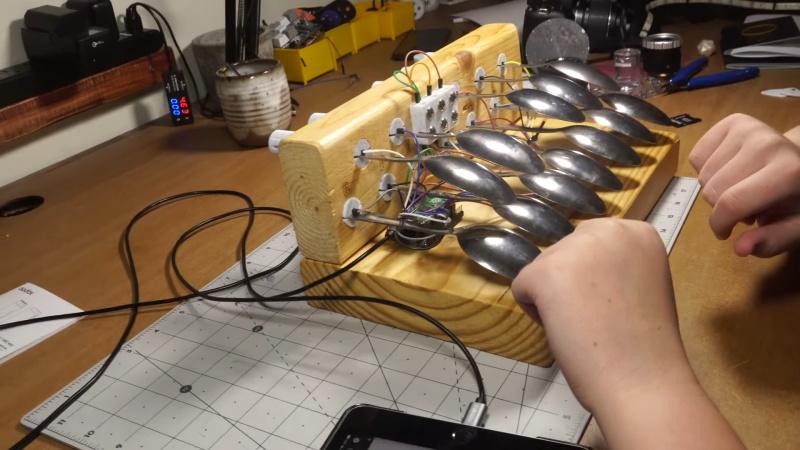Pianos traditionally had keys made out of ivory, but there’s a great way to avoid that if you want to save the elephants. You can build a keyboard using spoons, as demonstrated by [JCo Audio].
The build relies on twelve metal spoons to act as the keys of the instrument. They’re assembled into a wooden base in a manner roughly approximating the white and black keys of a conventional piano keyboard, using 3D-printed inserts to hold them in place. They’re hooked up to a Raspberry Pi Pico via a Pico Touch 2 board, which allows the spoons to be used as capacitive touch pads. Code from [todbot] was then used to take input from the 12 spoons and turn it into MIDI data. From there, hooking the Pi Pico up to a PC running some kind of MIDI synth is enough to make sounds.
It’s a simple build, but a functional one. Plus, it lets you ask your friends if they’d like to hear you play the spoons. The key here is to make a big show of hooking your instrument up to a laptop while explaining you’re not going to play the spoons a la the folk instrument, but you’re going to play a synth instead. Then you should use the spoon keyboard to play emulated spoon samples anyway. It’s called doubling down. Video after the break.
















I hope he plays Spoonman!
+1 ” Come on wack it off ” 🤘🎵🎶
“Pianos traditionally had keys made out of ivory, but there’s a great way to avoid that if you want to save the elephants.”
I know it’s just a throwaway comment to get the post started, but it’s also yet another example of the basic economic ignorance so common in the technical/engineering/Hackaday communities. It’s not that it’s any worse than other communities – in fact given exposure to signals and information concepts a lot of engineers understand bits of economics those with formal training don’t. It’s still pretty bad, though.
If you want to preserve a resource the best way to do so is to codify its value in property rights and capture that value by making it available for exchange – licitly. That encourages quantification of the value and maintenance of the underlying process which produces it. It’s also exactly what has been done to save several large land animals in Africa, including the elephant, to great success relative to other, naive approaches.
Otherwise, great post. I was just thinking about exploring a related build concept with different wavelength LEDs associated with keys for visual feedback to the more tonally-impaired player.
eh, i’m not gonna say that such an economization approach can’t work. but it has its limits too. licit markets with externalities priced in can shrink illicit markets at the margins, just like law enforcement can, but it’s not a magic bullet just because you read it in a milton friedman book. it’s effectiveness can be measured as well and found wanting, depending on your goals.
but mostly, the ignorance you posit wasn’t present in the source material you cited. Lewin was using a preposterous motivation for a hack as a lede to tell the story. the fact of the matter is that buying a yamaha or steinway or any other modern factory-produced piano is a perfectly fine way to avoid harvesting new ivory, and i don’t think this article obscures that fact.
i don’t even like music instrument hacks generally but “you can do all manner of fun things with capacitive touch sensors” is a constant theme of hackaday and is honestly a little inspirational to me, in that it makes me consider how easy it is to use diverse I/O on microcontrollers.
Thanks so much for the writeup Lewin!
I have a wooden “Catpaws” by (Steve) Catania Folk Instruments in Pennsylvania. Cost me around $20 about 10-15 years ago, they are a lot of fun. Definitely takes some practice to play them rhythmically.
Korg recently demonstrated Acoustic Synthesis Phase8. Which is a pretty weird instrument. It is a set of tuned steel tines, hammers, and magnetic-induction to turn a Kalimba-like device into a synth. Including VCA (voltage-controlled amplifier) and filters. You can shape the attack/decay envelope of the VCA, or use, what I assume is an electro magnet, to provide infinite sustain (swell).
Using spoons as a touch keyboard is very cool. I think a small modification could multiply the utility. If you had a piezo element per spoon, and a way for the microcontroller to process that signal. Then you can use the piezo to also send the Note Velocity MIDI message. If there piezo is very firmly attached to a flex point, you might even have the ability to do MIDI after touch messages, but mechanically that’s going to be more complicated.
Also with piezo triggers you could put your firmware in a “drum” mode and play it with sticks or your fingers and send the MIDI notes to a drum channel and process just the piezo that way and ignore the touch events.
If you only have enough I/Os to handle one more sensor. Then wrapping a piezo ribbon around all your spoons (Adafruit sells them) would let you detect the strength of a hit, even if you can’t detect it per note. Not unusual for lower-end MIDI controller keyboards to have this limitation.